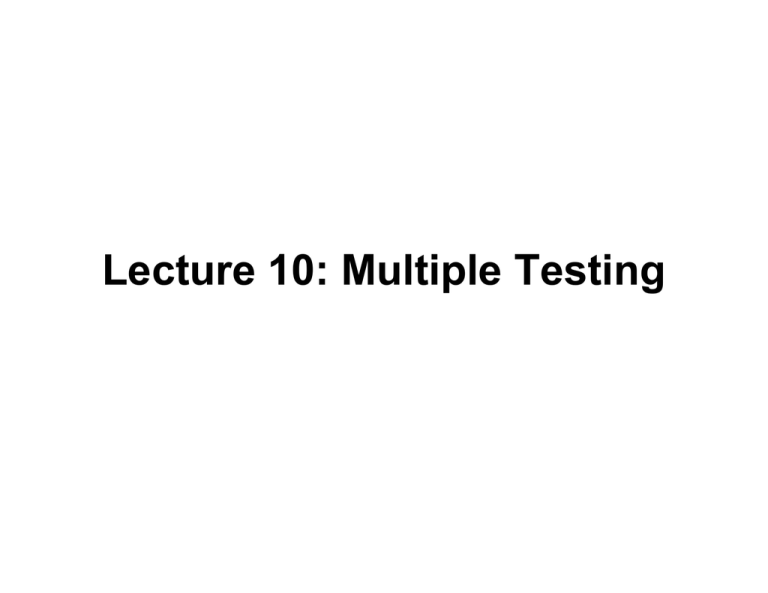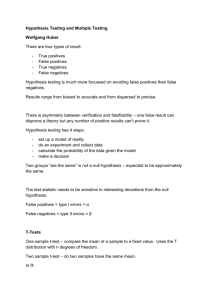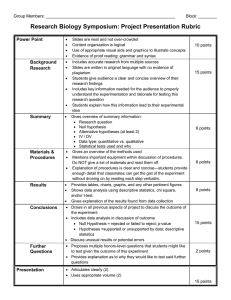Lecture 10: Multiple Testing
advertisement

Lecture 10: Multiple Testing
Goals
• Define the multiple testing problem and related
concepts
• Methods for addressing multiple testing (FWER
and FDR)
• Correcting for multiple testing in R
Type I and II Errors
Actual Situation “Truth”
Decision
H0 True
H0 False
Do Not
Reject H0
Correct Decision
1-α
Incorrect Decision
Type II Error
β
Rejct H0
Incorrect Decision
Type I Error
α
Correct Decision
1-β
" = P(Type I Error ) ! = P(Type II Error )
Why Multiple Testing Matters
Genomics = Lots of Data = Lots of Hypothesis Tests
A typical microarray experiment might result in performing
10000 separate hypothesis tests. If we use a standard p-value
cut-off of 0.05, we’d expect 500 genes to be deemed
“significant” by chance.
Why Multiple Testing Matters
• In general, if we perform m hypothesis tests, what is the
probability of at least 1 false positive?
P(Making an error) = α
P(Not making an error) = 1 - α
P(Not making an error in m tests) = (1 - α)m
P(Making at least 1 error in m tests) = 1 - (1 - α)m
Probability of At Least 1 False Positive
Counting Errors
Assume we are testing H1, H2, …, Hm
m0 = # of true hypotheses R = # of rejected hypotheses
Not Called
Significant
Called
Significant
Null
True
Alternative
True
Total
U
T
m-R
V
S
R
m0
m-m0
m
V = # Type I errors [false positives]
What Does Correcting for Multiple
Testing Mean?
• When people say “adjusting p-values for the number of
hypothesis tests performed” what they mean is
controlling the Type I error rate
• Very active area of statistics - many different methods
have been described
• Although these varied approaches have the same goal,
they go about it in fundamentally different ways
Different Approaches To Control Type I Errors
• Per comparison error rate (PCER): the expected value of the number
of Type I errors over the number of hypotheses,
PCER = E(V)/m
• Per-family error rate (PFER): the expected number of Type I errors,
PFE = E(V).
• Family-wise error rate: the probability of at least one type I error
FEWR = P(V ≥ 1)
• False discovery rate (FDR) is the expected proportion of Type I errors
among the rejected hypotheses
FDR = E(V/R | R>0)P(R>0)
• Positive false discovery rate (pFDR): the rate that discoveries are
false
pFDR = E(V/R | R > 0)
Digression: p-values
• Implicit in all multiple testing procedures is the
assumption that the distribution of p-values is
“correct”
• This assumption often is not valid for genomics data
where p-values are obtained by asymptotic theory
• Thus, resampling methods are often used to calculate
calculate p-values
Permutations
1. Analyze the problem: think carefully about the null and
alternative hypotheses
2. Choose a test statistic
3. Calculate the test statistic for the original labeling of the
observations
4. Permute the labels and recalculate the test statistic
•
Do all permutations: Exact Test
•
Randomly selected subset: Monte Carlo Test
5. Calculate p-value by comparing where the observed test
statistic value lies in the permuted distributed of test statistics
Example: What to Permute?
• Gene expression matrix of m genes measured in 4 cases
and 4 controls
Gene
1
2
3
4
Case 1
X11
X21
X31
X41
Case 2
X12
X22
X32
X42
Case 3
X13
X23
X33
X43
Case 4
X14
X24
X34
X44
Control 1
X15
X25
X35
X45
Control 2
X16
X26
X36
X46
Control 3
X17
X27
X37
X47
Control 4
X18
X28
X38
X48
m
Xm1
Xm2
Xm3
Xm4
Xm5
Xm6
Xm7
Xm8
..
.
..
.
..
.
..
.
..
.
..
.
..
.
..
.
..
.
Back To Multiple Testing: FWER
• Many procedures have been developed to control the
Family Wise Error Rate (the probability of at least one
type I error):
P(V ≥ 1)
• Two general types of FWER corrections:
1. Single step: equivalent adjustments made to each
p-value
2. Sequential: adaptive adjustment made to each pvalue
Single Step Approach: Bonferroni
• Very simple method for ensuring that the overall Type I
error rate of α is maintained when performing m
independent hypothesis tests
• Rejects any hypothesis with p-value ≤ α/m:
p˜ j = min[mp j , 1]
• For example, if we want to have an experiment wide Type I
error rate of 0.05 when we perform 10,000 hypothesis tests,
we’d
! need a p-value of 0.05/10000 = 5 x 10-6 to declare
significance
Philosophical Objections to Bonferroni
Corrections
“Bonferroni adjustments are, at best, unnecessary
and, at worst, deleterious to sound statistical
inference” Perneger (1998)
• Counter-intuitive: interpretation of finding depends on the
number of other tests performed
• The general null hypothesis (that all the null hypotheses are
true) is rarely of interest
• High probability of type 2 errors, i.e. of not rejecting the
general null hypothesis when important effects exist
FWER: Sequential Adjustments
• Simplest sequential method is Holm’s Method
Order the unadjusted p-values such that p1 ≤ p2 ≤ … ≤ pm
For control of the FWER at level α, the step-down Holm adjusted pvalues are
p˜ j = min[(m " j + 1) • p j , 1]
The point here is that we don’t multiply every pi by the same factor m
• For
!example, when m = 10000:
p˜1 = 10000 • p1, p˜ 2 = 9999 • p2 ,..., p˜ m = 1• pm
Who Cares About Not Making ANY
Type I Errors?
• FWER is appropriate when you want to guard against
ANY false positives
• However, in many cases (particularly in genomics) we
can live with a certain number of false positives
• In these cases, the more relevant quantity to control is
the false discovery rate (FDR)
False Discovery Rate
Not Called
Significant
Called
Significant
Null
True
Alternative
True
Total
U
T
m-R
V
S
R
m0
m-m0
m
V = # Type I errors [false positives]
• False discovery rate (FDR) is designed to control the proportion
of false positives among the set of rejected hypotheses (R)
FDR vs FPR
Not Called
Significant
Called
Significant
Null
Alternative
True
True
Total
U
T
m-R
V
S
R
m0
m-m0
m
V
FDR =
R
V
FPR =
m0
Benjamini and Hochberg FDR
• To control FDR at level δ:
1. Order the unadjusted p-values: p1 ≤ p2 ≤ … ≤ pm
2. Then find the test with the highest rank, j, for which the p
value, pj, is less than or equal to (j/m) x δ
3. Declare the tests of rank 1, 2, …, j as significant
j
p( j) " #
m
B&H FDR Example
Controlling the FDR at δ = 0.05
Rank (j)
P-value
(j/m)× δ
Reject H0 ?
1
0.0008
0.005
1
2
0.009
0.010
1
3
0.165
0.015
0
4
0.205
0.020
0
5
0.396
0.025
0
6
0.450
0.030
0
7
0.641
0.035
0
8
0.781
0.040
0
9
0.900
0.045
0
10
0.993
0.050
0
!
Storey’s positive FDR (pFDR)
"V
%
BH : FDR = E $ | R > 0'P(R > 0)
#R
&
!
"V
%
Storey : pFDR = E $ | R > 0'
#R
&
• Since P(R > 0) is ~ 1 in most genomics experiments FDR
and pFDR are very similar
• Omitting P(R > 0) facilitated development of a measure of
significance in terms of the FDR for each hypothesis
What’s a q-value?
• q-value is defined as the minimum FDR that can be attained when
calling that “feature” significant (i.e., expected proportion of false
positives incurred when calling that feature significant)
• The estimated q-value is a function of the p-value for that test
and the distribution of the entire set of p-values from the family of
tests being considered (Storey and Tibshiriani 2003)
• Thus, in an array study testing for differential expression, if gene X
has a q-value of 0.013 it means that 1.3% of genes that show pvalues at least as small as gene X are false positives
Estimating The Proportion of Truly Null
Tests
• Under the null hypothesis p-values are expected to be uniformly
distributed between 0 and 1
30000
20000
10000
0
Frequency
40000
50000
Distribution of P-values under the null
0.0
0.2
0.4
0.6
P-values
0.8
1.0
Estimating The Proportion of Truly Null
Tests
0
500
Frequency
1000
1500
• Under the alternative hypothesis p-values are skewed towards 0
0.0
0.2
0.4
0.6
P-value
0.8
1.0
Estimating The Proportion of Truly Null
Tests
3000
2000
1000
0
Frequency
4000
5000
• Combined distribution is a mixture of p-values from the null and
alternative hypotheses
0.0
0.2
0.4
0.6
P-value
0.8
1.0
Estimating The Proportion of Truly Null
Tests
3000
2000
1000
0
Frequency
4000
5000
• For p-values greater than say 0.5, we can assume they mostly
represent observations from the null hypothesis
0.0
0.2
0.4
0.6
P-value
0.8
1.0
Definition of π0
• "ˆ 0 is the proportion of truly null tests:
"ˆ 0 ( #) =
#{ pi > #;i = 1,2,...,m}
m(1$ #)
3000
0
1000
2000
Frequency
!
4000
5000
!
0.0
0.2
0.4
0.6
0.8
1.0
P-value
• 1 - "ˆ 0 is the proportion of truly alternative tests (very useful!)






